

“Iconic” is kind of an overused term these days, but in the case of the Jeep Wrangler, it’s totally appropriate. The Wrangler is a direct descendant of a bloodline that goes back farther than most any modern-day vehicle can claim. The star-spangled WWII heritage, the long-running (and tumultuous) history, the unmistakable profile and styling details, and, of course, the legendary off-road prowess—it’s all part of the mix.
10 Cool Things about the 2018 Jeep Wrangler
So when a beloved automotive icon like the Wrangler gets a ground-up redesign, it’s a big deal for a number of reasons. For one, Wrangler re-dos don’t come around very often; though it saw many noteworthy updates over its 12-year lifespan, the outgoing Wrangler (which, by the way, continues for the 2018 model year as the Wrangler JK) debuted way back in 2006 as a 2007 model.
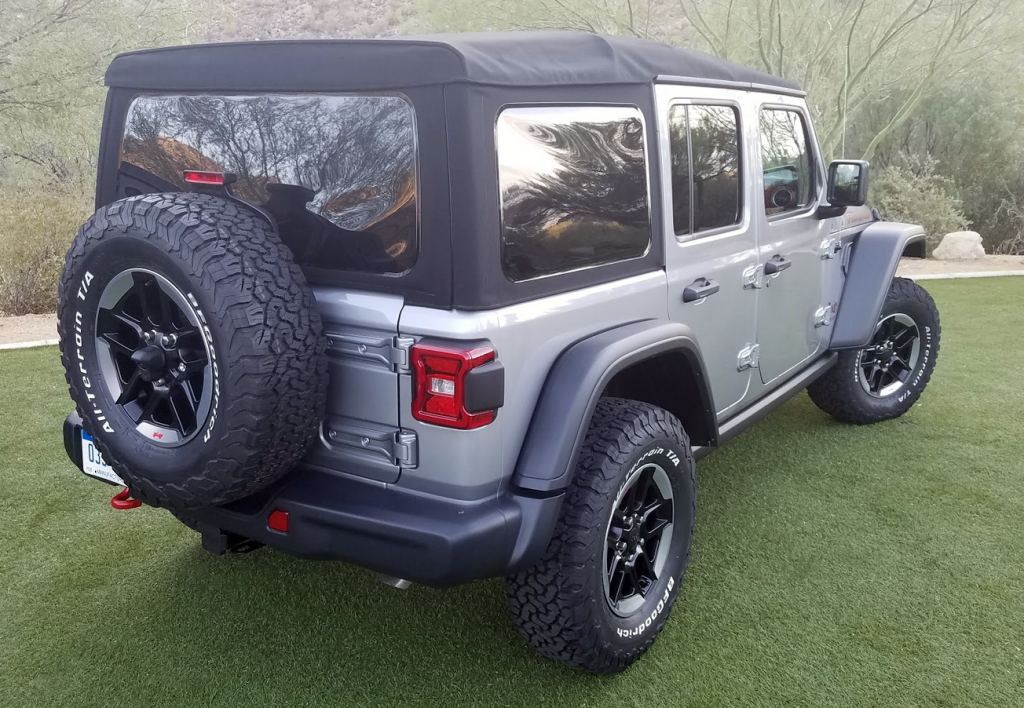
Plus, icon status and a fervent fan base bring both obligations and certain liberties. In some ways, the Wrangler’s trademark styling and rugged personality have rendered it exempt from normal expectations about fuel economy and on-road refinement. Sure, the Wrangler sometimes felt like a farm implement compared to other off-road vehicles… that’s part of its appeal. A Wrangler is cool enough to make its drivers seem a little more hardy and adventurous just by proxy—even if they rarely (or never) use its formidable off-road capabilities.
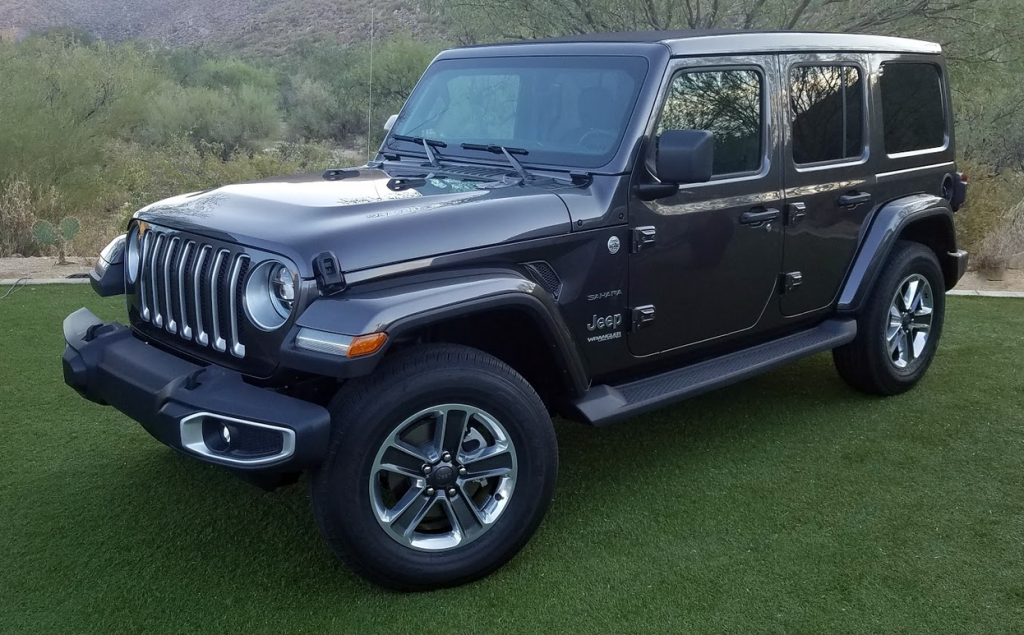
Still, time and technology marches on, as does the competition. Land Rover is gearing up for a re-launch of its rugged Defender model—perhaps in late 2018 or early 2019—and Ford is working on a reborn Bronco (which could be a heritage-styled vehicle) as a 2020 model. Both of these rival off-roaders could siphon off Wrangler intenders.
The challenge for Jeep designers in creating the redesigned 2018 Wrangler was to walk the tightrope of maintaining the time-honored character and the rugged, purpose-built feel while integrating new technologies and aiming for better fuel economy and all-around refinement. We test-drove pre-production 2018 Wranglers both on-road and in difficult off-road terrain just outside Tucson, Arizona, to see how they did.
First Spin: 2018 Jeep Grand Cherokee Trackhawk
Good Bones
First off, the core architecture of the Wrangler—a body-on-frame design with solid front and rear axles, exceptionally short front and rear overhangs, a tailgate-mounted full-size spare tire, and an integral roll-cage structure—stays true to concept.
The fully boxed frame uses high-strength steel for reduced weight and improved torsional rigidity. The body retains a steel structure, but there is more high-strength steel, and the doors, hinges, fenders, and windshield frame are all aluminum. The rear swing gate has a magnesium inner structure with an aluminum outer skin. In all, engineers were able to make the frame nearly 100 pounds lighter and the body assembly about 200 pounds lighter than those of the previous-generation Wrangler.
The model lineup stays mostly the same as before. Sport, Sport S, and Rubicon models are offered in both 2-door and 4-door body styles. The Sahara trim level is restricted to the 4-door version.
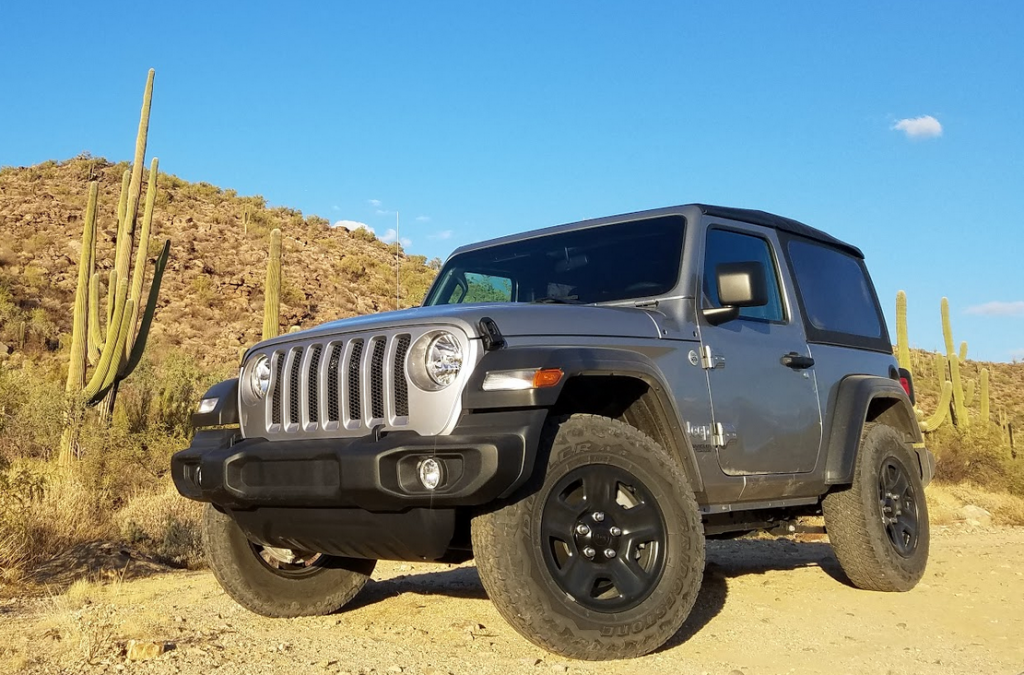
Under the Hood
The standard 3.6-liter Pentastar V6 is carried over for the most part, but it now gets a fuel-saving auto stop/start feature and an 8-speed automatic transmission in place of the previous 5-speed automatic. It makes 285 horsepower and 260 pound-feet of torque and is rated at 18 mpg city/23 mpg highway/20 mpg combined with the automatic and 17/23/19 with the available 6-speed manual transmission. These numbers represent improvements of 1-2 mpg over the previous-generation Wrangler.
The bigger news is the optional engine: an all-new turbocharged 2.0-liter inline 4-cylinder with direct injection, variable valve timing, and 48-volt “eTorque” mild-hybrid technology. It produces 270 horsepower and 295 lb-ft of torque and is available solely with the 8-speed automatic. The eTorque system’s functions include auto start/stop, electric power assist, intelligent battery charging, and regenerative braking. The engine and fuel flow may both be turned off during stops, coasting, or deceleration. Jeep has not yet released fuel-economy numbers for the new 2.0 as of this writing; hopefully all the new technology pays some real mpg dividends.
And more powertrain proliferation is on the horizon. Jeep says that a 3.0-liter EcoDiesel V6 (rated at 260 horsepower and 442 lb-ft of torque) is slated for the 2019 model year, and a plug-in hybrid version is in the works for 2020.
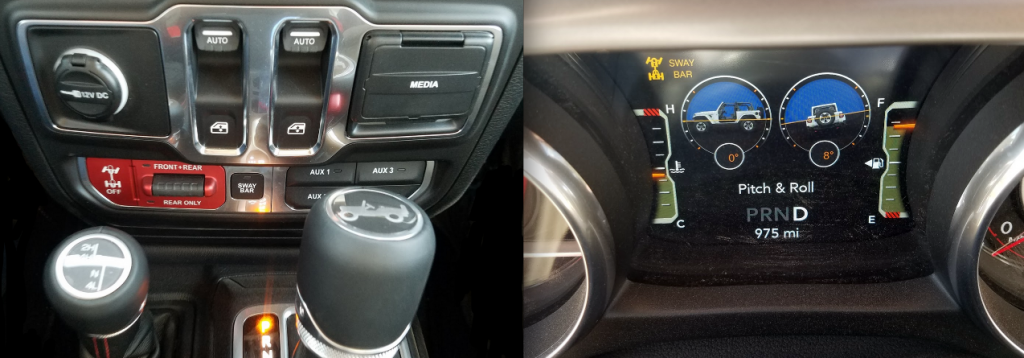
The Wrangler’s four-wheel-drive systems are also expanded with the redesign. The base Command-Trac setup (standard on Sport and Sahara models) has a part-time, two-speed transfer case that can be engaged while in motion at speeds of up to 55 mph. Command-Trac features a 2.72:1 low-gear range for rock-crawling and Dana 30 front/Dana 35 rear axles.
Rubicon models come standard with the Rock-Trac system, which includes heavy-duty Dana 44 front and rear axles with Tru-Lok electronic locking differentials and an electronic front sway-bar disconnect, as well as a 4:1 low gear ratio. (Non-Rubicon models offer a Trac-Lok limited-slip rear differential as an option.)
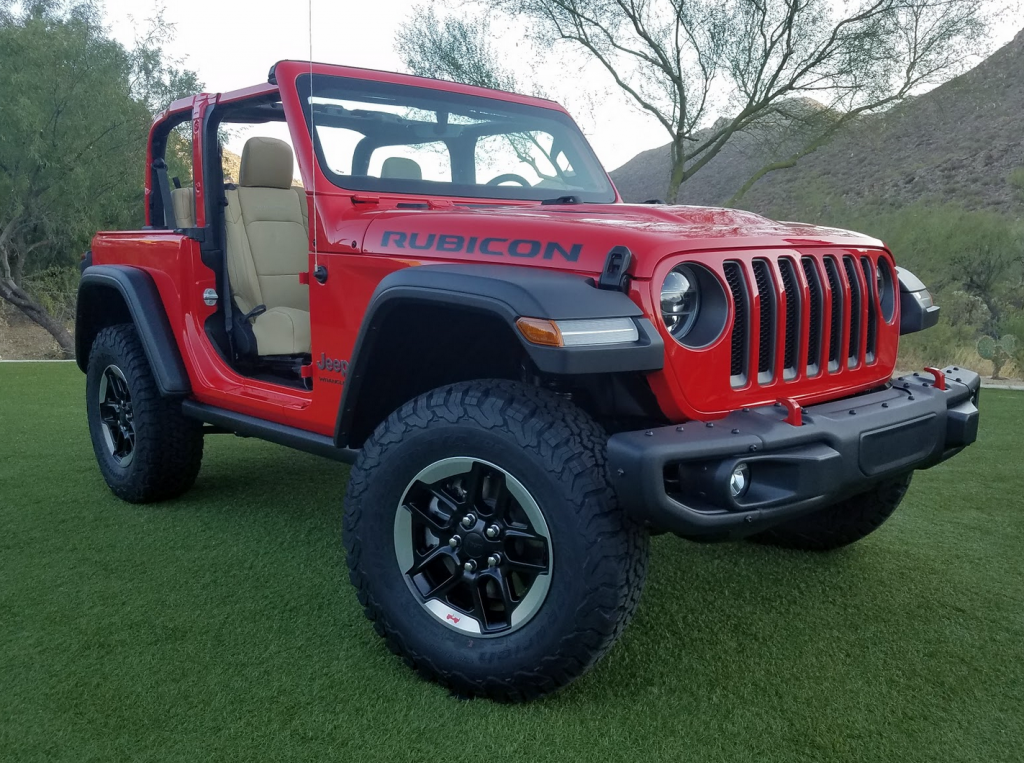
Available solely on Sahara models is the Wrangler’s first full-time 4-wheel-drive system. The Selec-Trac two-speed transfer case offers “set and forget” functionality that constantly sends power to the front and rear axles. Like the Command-Trac system, Selec-Trac also features a 2.71:1 low-gear range.
What is the difference between 4WD and AWD?
Exterior Design
At a quick glance, the new Wrangler doesn’t appear to be radically different from its predecessor, but the more you look, the more you see how much has changed. All of those signature styling traits are present, but the details are different. The outer slots of the seven-slot grille now are intersected slightly by the headlights, a subtle homage to the Jeep CJ. The bumpers are a bit more sculpted than before, and a bit narrower too. A new vent just aft of the front fenders is a functional feature; it relieves under-hood air pressure. The nose is slightly sleeker and the windshield is more steeply raked—no Wrangler is what you’d call a wind-cheating vehicle, but the aero performance has been enhanced on the new model.
Window glass is larger all around, and the beltline is lower, which makes for a slightly airier feel inside the cabin. The tailgate and rear window are wider, and the spare tire and CHMSL (center high-mounted stop lamp) are both moved down, which makes for improved (though still not great) rear visibility. One clever touch is that the CHMSL bracket is adjustable, so it can accommodate a larger-than-stock spare tire.
Rubicon models boast some exclusive features, such as an available winch- capable steel front bumper with removable end pieces, a standard dual-vented Power Dome hood, 17-inch BF Goodrich All-Terrain T/A tires, and front fenders mounted two inches higher than other Wranglers for improved off-road clearance. (Rubicons also have about an inch more ground clearance than other Wranglers; 10.9 inches versus 9.8.)
On all Wranglers, redesigned doors and door handles are a big step forward in practicality and convenience. There are now door hinges with detents, so the doors will now stay put when open instead of swinging freely—much easier to load kids or groceries in the vehicle when you don’t have to worry about propping the open door at the same time. In place of the sometimes-tedious push-button door handles on the previous Wrangler are simpler “one-pull” handles that have a similarly rugged look but are much easier to operate. Ease of entry and exit is further improved by the addition of well-placed grab handles for both the front and rear seats.
And don’t worry, hardcore Jeepers—the doors are still fully removable. In fact, there’s even a “Lift-Assist” handle molded into the inner door panel to make the doors easier to carry once they’re off the vehicle. Jeep says that a half-door design will be available for 2019.
Bring Sunscreen
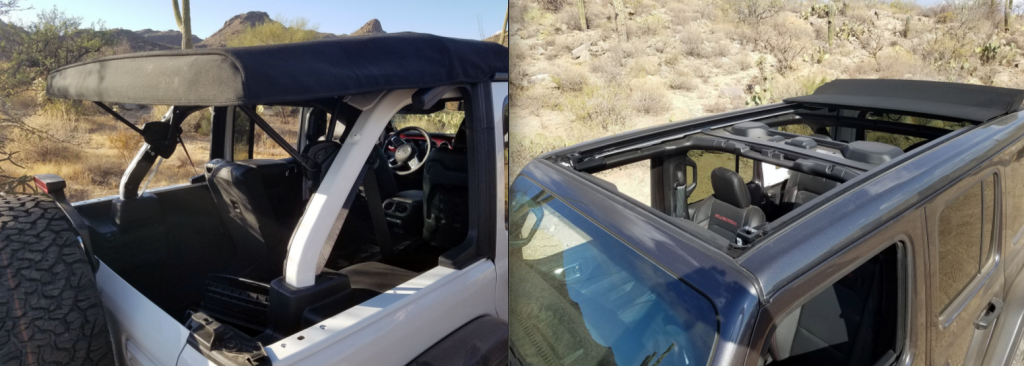
Speaking of open-air fun… removable soft tops and hard tops of various, often-complicated configurations have long been a Wrangler staple. The top options get a LOT better (read: less tedious and time-consuming to operate) with the redesign. Standard on all models is a Sunrider folding soft top with a sunroof feature, and a premium Sunrider top is available. The soft tops are much easier to raise and lower than before, and the rear windows are removable without taking off the top itself, which makes for a neat “Bimini top” feel.
A “Freedom Top” black three-piece hardtop is optional on all Wranglers; Sahara and Rubicon models can be equipped with a body-color hardtop. A new Sky One-Touch power top for four-door Sahara and Rubicon models features a retractable canvas sunroof that runs the full length of the vehicle, along with easily removable side windows for an enhanced open-air feel.
Open-air-loving Wrangler fans will be happy to know that the new model retains a fold-down windshield—and it’s much easier to use than before. Simply remove four bolts (compared to 28 on the previous Wrangler), and the windshield drops down in about four minutes. A new header bar connects the A-pillars and allows the rearview mirror to remain in place with the windshield folded.
Test Drive: 2017 Toyota 4Runner TRD Off-Road
Inside Story
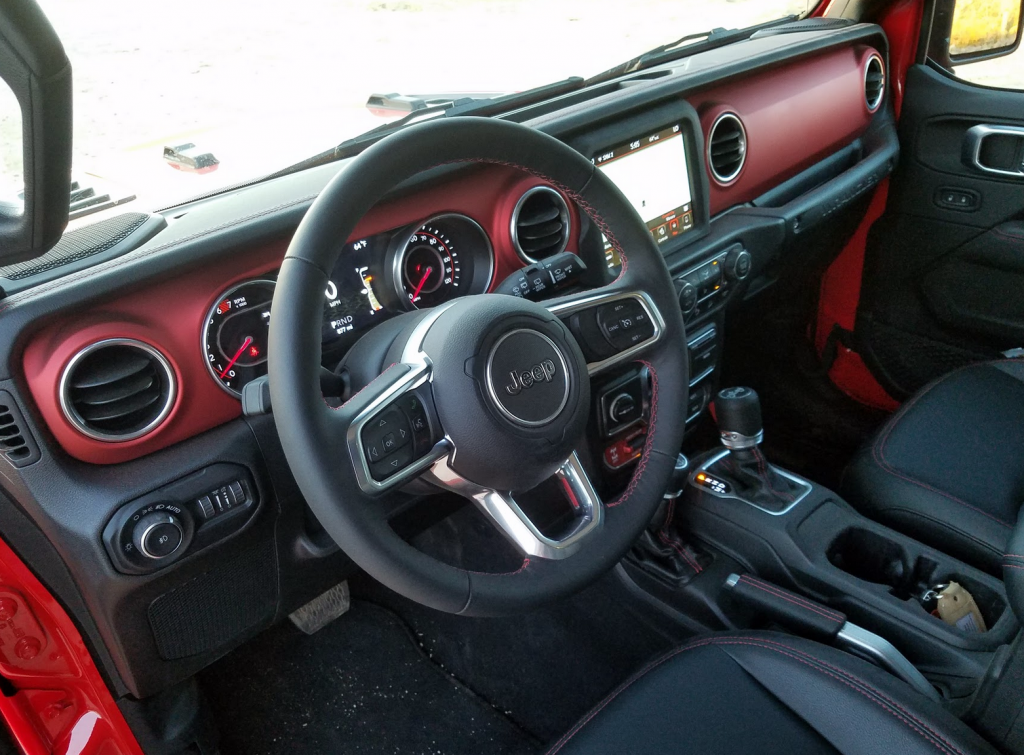
The new Wrangler’s cabin retains that classic Jeep look and feel while significantly upping the overall quality and refinement level (particularly on the Sahara and Rubicon models). Fun design touches abound, such as satin-metal trim and various “Easter egg” heritage-themed details. The Wrangler’s characteristic “flat and shallow” dash remains; the overall control interface is ergonomically unique for sure, but most controls are logically placed and easy to use. It always takes us a while to get used to the center-mounted window controls, but they would quickly become second nature to an owner. The steering wheel now tilts and telescopes, which makes it easier to dial in an optimal driving position (previous Wranglers were tilt-only).
The available Uconnect infotainment systems are Jeep’s latest fourth-generation units, which include features such as Apple CarPlay/Android Auto functionality, smartphone-like pinch-and-zoom capability, and a choice of 7.0- or 8.4-inch touchscreens. The 8.4-inch system worked well in our test drives; it has clear graphics and large virtual buttons, quick response times, and a broad range of helpful features. A 3.5-inch configurable driver-information display is standard, and a more feature-rich 7-inch display is available. We especially appreciated the Off Road Pages information, which includes a Pitch & Roll graphic readout for extreme off-roading.
Other welcome new additions include keyless entry and starting, LED interior lighting, available LED headlights and taillights, and an available heated steering wheel. Newly available safety features include blind-spot alert, rear cross-traffic alert, and rear park assist.
The Wrangler’s tall, boxy body means headroom is more than adequate in both the front and back seats, but front-seat legroom is rather cramped for extra-tall occupants. The back-seat area is sized for children and very difficult to access on 2-door Wranglers, but it’s surprisingly spacious on the longer-wheelbase 4-door version. Average-sized adults will be able to sit in comfort, though the narrow door openings and high step-in can complicate entry and exit.
Small-items storage isn’t great overall—the glovebox is stingy, and the center console is on the small side as well—but there are some handy touches nonetheless. There’s a small storage bin underneath the rear cargo-area floor on 4-door models, and the front seat backs can be equipped with military-style MOLLE (for Modular Lightweight Load-carrying Equipment) panels for accessory attachment.
Behind the Wheel
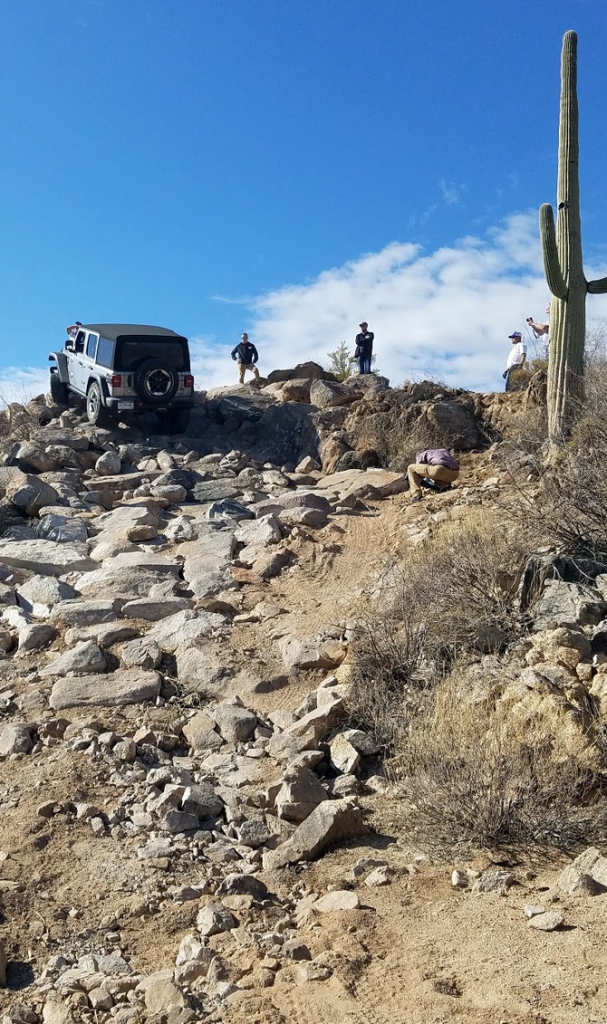
We had the opportunity to sample a handful of Wranglers both on and off-road during our press-preview test drive. Jeep says the suspension was tuned to optimize on-road handling and ride comfort without sacrificing off-road capability. The Wrangler’s mountain-goat capabilities continue unabated; we took Rubicon models on an extremely challenging off-road course that included extra-steep ascents over large, loose rocks, and the Jeeps didn’t miss a beat.
The on-road ride is more controlled and less “wallowy” than before, but it’s still rather stiff and somewhat brittle over anything but glass-smooth pavement—particularly on the shorter-wheelbase 2-door models. However, most Wrangler shoppers will willingly make the trade-off in comfort, just like sports-car buyers will tolerate a taut ride for superior corner-carving capability.
Electro-hydraulic steering is now standard equipment in all Wranglers. The steering still has a direct, accurate feel at very low speeds—very important for precise adjustments on a challenging off-road course—but it is noticeably less “nervous” in on-road driving. We found ourselves having to make fewer minor course corrections at highway speeds than we did in previous Wranglers.
The V6 supplies better-than-adequate acceleration all-around, and the turbo 4-cylinder is surprisingly energetic. Punch the four’s throttle, and—after a tiny bit of lag as the turbo spools up—it shoots forward with satisfying zip. On both engines, the stop/start feature functioned smoothly. The 8-speed automatic transmission works well with both powertrains, with smooth, timely shifts and no apparent “hunting” for the right gear. The V6-only 6-speed manual is much more refined than in previous Wranglers; it has a big, hefty shift knob and smooth shift-lever/clutch-pedal action.
More Jeep: Why I Want Another CJ-7
The Bottom Line
If you’ve got a hankering for a new Wrangler, you won’t have to wait long; it’s slated to start hitting Jeep dealers in January. Pricing starts out at $26,995 for the base Sport 2-door model, $30,495 for the Sport 4-door, and $37,345 for the 4-door-only Sahara. As before, the Rubicon commands a significant price premium: $36,995 to start for the 2-door version, and $40,495 for the 4-door. None of the above prices include destination, which is a hefty $1195. Across the board, the 2018 Wrangler’s base prices represent a jump of about $3000 over the respective 2017 models… and we haven’t yet seen official numbers for all the optional equipment, which is sure to pump up the sticker prices as well. We’re especially curious to see how much the high-tech turbo 4-cylinder will add to the bottom line.
Wranglers have never exactly been bargain-priced, but they apparently don’t have to be, because there’s really nothing else on the market that can match the rugged style, singular personality, heritage, and off-road capability of the Jeep of Jeeps. The redesigned 2018 Wrangler is a worthy successor; it upholds proud Jeep tradition while deftly integrating up-to-date technology features and improved refinement and efficiency.




